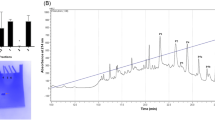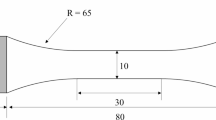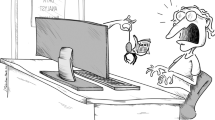Abstract
It is very important for living creatures to have trust in most of the environments encountered in daily life. However, there have been no reports evaluating the degree of trust in such environments, including the quality of materials. The mechanical properties of a spider dragline may be considered an appropriate object for studying trust in the quality of materials such as fibers, textiles and plastics, because a spider must trust its life to the dragline when falling. In this study, the stress–strain curves of a dragline, and the effects of ultraviolet rays on its mechanical properties, were found to present an origin for evaluating the degree of trust on the quality of materials. Hypothetically, spiders may have trust in only the linear region of the stress–strain curve, where there is no possibility of the dragline breaking; they may have no confidence in the nonlinear region where there is the risk of breakage. Thus, the degree of trust could be estimated by establishing whether there is a linear relationship between stimulus and response and by determining the slope of the straight line. The concept of trust developed here is applicable to specifications for various industrial materials and also to social phenomena.
Similar content being viewed by others
Log in or create a free account to read this content
Gain free access to this article, as well as selected content from this journal and more on nature.com
or
References
Lord, P. R. Short fibres and quality control. J. Text. Inst. 76, 388–390 (1985).
Glaeser, E., Laibson, D. I., Scheinkman, J. & Soutter, C. Measuring trust. Quarterly J. Econom. 115, 811–846 (2000).
Molm, L. D., Takahashi, N. & Peterson, G. Risk and trust in social exchange: an experimental test of a classical proposition. Am. J. Sociol. 105, 1396–1427 (2000).
Alesina, A. & Eliana, L. F. Who trusts others? J. Publ. Econom. 85, 207–234 (2002).
Cook, K. S., Yamagishi, T., Cheshire, C., Cooper, R., Matsuda, M. & Mashima, R. Trust building taking: a cross-societal experiment. Social Psychol. Quarterly 68, 121–142 (2005).
Work, R. W. & Morosoff, N. S. A physico-chemical study of the supercontraction of spider major ampullate silk fibers. Text. Res. J. 52, 349–356 (1982).
Gosline, J. M., Denny, M. W. & DeMond, M. E. Spider silk as rubber. Nature 309, 551–552 (1984).
Osaki, S. Aging of spider silks. Acta. Arachnol. 43, 1–4 (1994).
Vollrath, F. Biology of spider silk. Int. J. Biol. Macromol. 24, 81–88 (1999).
Osaki, S., Yamamoto, K., Kajiwara, A. & Murata, M. Evaluation of the resistance of spider silk to ultraviolet irradiation. Pol. J. 36, 623–627 (2004).
Osaki, S. Ultraviolet rays mechanically strengthen spider's silks. Pol. J. 36, 657–660 (2004).
Brandwood, A. Mechanical properties and factors of safety of spider drag-lines. J. Exp. Biol. 116, 141–151 (1985).
Becker, M. A., Mahoney, D. V., Lenhert, P. G., Eby, R. K., Kaplan, D. & Adams, W. W. in Silk Polymers (eds Kaplan, D. et al.) 185–195 (American Chemical Society Washington, DC, 1994).
Cunniff, P. M., Fossey, S. A., Auerbach, M. A. & Song, J. W. in Silk Polymers (ACS Symposium Series 544) (eds Kaplan, D. et al.), 234–251 (American Chemical Society: Washington, DC, 1994).
Termonia, Y. in Structural Biological Materials (ed. Elices, M.), 335 (Pergamon Press, Amsterdam, 2000).
Perez-Rigueiro, J., Elices, M., Llorca, J. & Viney, C. Tensile properties of Argiope trifasciata drag line silk obtained from spider's web. J. Appl. Polym. Sci. 82, 2245–2251 (2001).
Osaki, S. & Ishikawa, R. Determination of elastic modulus of spider's silks. Pol. J. 34, 25–29 (2002).
Osaki, S. in Macromolecular Nanostructured Materials (eds Ueyama N. & Harada, A.), 297–320 (Kodansha Springer, Berlin Heidelberg, 2004).
Osaki, S. Spider silk as mechanical lifeline. Nature 348, 419 (1996).
Osaki, S. Is the mechanical strength of spider's drag-lines reasonable as lifeline? Int. J. Biol. Macro. 24, 283–287 (1999).
Osaki, S. Safety coefficient of the mechanical lifeline of spiders. Pol. J. 35, 261–265 (2003).
Osaki, S. Allowable mechanical stress applied to a spider's lifeline. Pol. J. 39, 267–270 (2007).
Osaki, S. Thermal properties of spider's thread. Acta. Arachnol. 37, 69–75 (1989).
Foelix, R. E. Biology of Spiders 109 (Harvard University Press Cambridge, England, 1982).
Hayashi, C. Y., Shipley, N. H. & Lewis, R. V. Hypotheses that correlate the sequence, structure, and mechanical properties of spider silk proteins. Int. J. Biol. Macromol. 24, 271–275 (1999).
Scheibel, T. Spider silks: recombinant synthesis, assembly, spinning, and engineering of synthetic proteins. Microb. Cell Fact. 3, 14–24 (2004).
Osaki, S. & Osaki, M. Evolution of spiders from nocturnal to diurnal gave spider silks mechanical resistance against UV irradiation. Polym. J. (e-pub ahead of print 8 December 2010; doi:10.1038/pj:2010.119).
Grobbelaar, C. J., du Plessis, T. A. & Marais, F. The radiation improvement of polyethyelene prostheses. A preliminary study. J. Bone Joint Surg. 60-B, 370–374 (1987).
Yokota, R. Mechanical properties: increase in mechanical properties ascribed to high polymerization. Kobunshi (in Japanese). 39, 371 (1990).
Nishikubo, T., Kameyama, A., Tsutsui, K. & Iyo, M. Synthesis and photochemical reaction of novel p-alkylcalix[6]arene. J. Polym. Sci. Part A Polym. Chem. 37, 1805–1814 (1999).
Marshall, I. & Todd, A. The thermal degradation of polyethylene terephthalate. Trans. Faraday Soc. 49, 67–78 (1953).
Matsuhira, T., Yamamoto, K. & Osaki, S. UV-resistivity of spider silk. Polym. Prept. Jpn. 59: NO 1 1887 (2010).
Author information
Authors and Affiliations
Corresponding author
Appendix
Appendix
Relationship between stimulus and response
In this model system, subordinates present their reports as the response, and the superior gives different types of orders with different grades to the subordinates as the stimulus. The reports presented by subordinates are plotted against the orders given by a superior. The superior is required to estimate the relative difficulty of routine tasks and rank the orders. The rank is usually estimated numerically from the number of routine tasks. Of course, the superior also has to provide a rank by assessing the level of quality of the tasks as accurate as possible even though numerical estimation is very difficult. This assessment is usually carried out in companies. The superior checks whether the relationship between the order and the report is linear, and evaluates the degree of trust in the subordinates from the slope and length of the straight line in the graph.
Relationship between superior and subordinate
The concept of trust developed through the study of the mechanical behavior of draglines may be applicable to various kinds of social phenomena. Here, a case in which a superior orders several subordinates to perform tasks at different levels of difficulty is considered. Even though the subordinates try to complete the work, they may not be able to achieve the level required by the superior. Generally, the superior cannot trust in the subordinate until the subordinate presents the reports expected. Therefore, a linear relationship will be established, within error, between the order and the report if there are several incidents in which the level of the report approximates the level of the superior's order. Generally, it is relatively easy to estimate numerically the degree of level, not for research, but for routine work. If linear behavior in the order–report relationship is established for routine work, as shown in cases A, B and C of Figure 5, the superior will trust the subordinate. The longer the straight line, the more widely the subordinate will be trusted by the superior, and the greater the slope of the line the higher the degree of trust. A greater slope means that the subordinate always presents effective results from the superior's order.
The reports presented by subordinates plotted against the orders given by a superior. Trust can be established between the superior and subordinate when the order–report relationship is linear. A higher slope reflects a higher degree of trust. The rank of evaluation for routine work is in the order of subordinates A, B and C. The superior is unable to trust subordinate D, as the level of this subordinate's report is random. Closed circles represent subordinate A, open circles represent subordinate B, closed squares represent subordinate C and open squares represent subordinate D.
Nonlinearity will be established between the superior's order and the subordinate's report for routine tasks if the level of the report is smaller than the level of expectation; as a result, the superior will not trust the subordinate. It is likely that nonlinearity will be established for difficult or unfamiliar tasks, which usually include surplus workload and research. Generally, a nonlinear relationship will be established in the region where the stimulus is very large and the position of the coordinate is very far from the origin.
The rank of evaluation for routine work in Figure 5 is in the order of subordinates A, B and C. However, the length of the linear region and the magnitude of the slope will change depending on the identity of the superior.
The case of D, in which the level of the subordinate's report is random with respect to order, corresponds to the example in which the subordinate does not have the ability to accomplish routine work or does not make appropriate efforts.
Sometimes, subordinates may have a special ability for accomplishing difficult work with a high level in the nonlinear region of the graph, as shown in cases A, B and C in Figure 5. However, most people do not have this ability. As a result, the rank of evaluation made by the superior may reverse for difficult or non-routine work such as research. Most people are unable to easily establish a linear relationship between a superior's order and subordinate's report for difficult research.
This notion of trust is also applicable to cases of learning and deceit, from the viewpoint of investment and profit. It can be assumed that investing money in schooling usually leads to profit through achievement. If profit increases linearly with increasing investment, many people will study hard. If the stream of future society is easily estimated in a similar way, people will also work hard. However, if the future is uncertain and cannot be perfectly estimated, linearity will not be established between effort and profit. As a result, people will make no effort to learn or to work hard.
Rules for deceit
In the second example, if the annual interest at a bank is usually very low, people will not expect to earn large sums when depositing small amounts of money (see Figure 6). However, one or two experiences of earning high profits from a small deposit, as a result of high interest, may alter their expectations. If there are two or three points, including an origin, a straight line can be drawn between the deposit and the interest. In such a case, people may believe that a linear relationship has been established, even far from the origin, and continue to invest, and, as a result, be easily deceived.
The relationship between interest as a profit and deposit as an investment. The interest is generally very low, even when a large amount of money is deposited (solid line). If there are two or three points (open circles), including an origin, a straight line can be drawn. If an investor makes a large profit through high interest on at least two occasions, they may trust in the linear relationship and estimate that continued investment will produce more profits (broken line). However, the investor may be deceived.
Rights and permissions
About this article
Cite this article
Osaki, S. Spiders' mechanical lifelines provide a key for the study of trust in the quality of materials. Polym J 43, 194–199 (2011). https://doi.org/10.1038/pj.2010.122
Received:
Revised:
Accepted:
Published:
Issue date:
DOI: https://doi.org/10.1038/pj.2010.122
Keywords
This article is cited by
-
Unravelling the biodiversity of nanoscale signatures of spider silk fibres
Nature Communications (2013)





